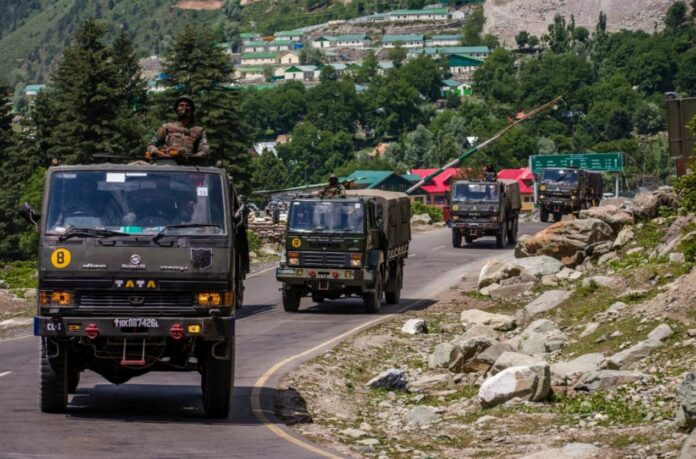Chinese intrusions into the western and central borders of India are not independent, unrelated occurrences that happen by accident. According to a recent study, these intrusions are actually a part of a strategically planned, coordinated campaign to seize long-term control of controversial border regions.
The authors put up a new dataset, compiling data about Chinese incursions into India from 2006 to 2020, under the direction of Northwestern University, the Technical University of Delft in the Netherlands, and the Netherlands Defence Academy. The data was then analysed using statistical techniques and game theory.
According to the analysts, there are two different sectors of conflict: west/middle (the Aksai Chin region), and east (the Arunachal Pradesh region). However, they came to the conclusion that the confrontations in the east and middle sectors are a part of a coordinated expansionist strategy while learning that the number of breaches is normally rising with time.
The researchers believe that by identifying the precise spots that are the source of the conflict, deterrents may be put in place there to ease tensions along the entire border.
The findings will appear in the journal PLOS ONE today.
“By studying the number of incursions that occurred in the west and middle sectors over time, it became obvious, statistically, that these incursions are not random,” remarks senior author V.S. Subrahmanian. “The probability of randomness is very low, which suggests to us that it’s a coordinated effort. When we looked at the eastern sector, however, there is much weaker evidence for coordination. Settling border disputes in specific areas could be an important first step in a step-by-step resolution of the entire conflict.”
The Walter P. Murphy Professor of Computer Science at Northwestern’s McCormick School of Engineering and a Buffett Faculty Fellow at Northwestern’s Buffett Institute for Global Affairs, Subrahmanian is a well-known expert on AI and security issues.
Rising incursions
The India-China border, which is the longest disputed border in the world, has seen ongoing confrontations since 1962. Incursions often take place in two distinct areas: Arunachal Pradesh, which is governed by India but claimed by China, and Aksai Chin, which is controlled by China but claimed by India and is located north of Nepal.
The authors assembled publicly accessible data about border incursions that were extensively covered by international media in order to create their new dataset. For the purposes of the study, the team defined a “incursion” as any Chinese soldier movement across the boundary, whether on foot or in a vehicle, into regions recognised internationally as belonging to India. The locations were then projected on a map, resulting in the identification of 13 hotspots where invasions take place most frequently.
The researchers found an average of 7.8 intrusions annually in the 15-year sample. The estimates made by the Indian government, however, are 300 each year, which is far higher.
“Although the Indian government publicizes these numbers, we don’t have the details behind them,” Subrahmanian adds. “They might be counting a series of temporally proximate events as several different incursions, whereas we count them all as part of the same one incursion. But when we plotted our data and their data on a graph, the curves still have the same shape. Both curves show that incursions are increasing — but not steadily. They rise and fall, while still trending upward.”
China’s game plan
Even while there are hotspots all over Aksai Chin and Arunachal Pradesh, the game-theory analysis conducted by the researchers shows that only the incursions in Aksai Chin are the result of a coordinated effort. Based on what they know about game theory, the researchers think that China is trying to take permanent control of Aksai Chin by sending more troops there for longer than India.
“China grabs a little bit of territory and then a little bit more until India accepts that it’s Chinese territory,” Subrahmanian adds. “There is a saying: ‘Keep the pot boiling but don’t let it boil over.’ China takes small pieces of land, but keeps it under the threshold of where India would counter-attack. But, over time, it becomes a bigger piece of land.”
According to Subrahmanian, the fact that China is primarily focused on acquiring Aksai Chin confirms widespread belief.
“Knowing there are more incursions in the western sector is not a surprise,” he adds. “Aksai Chin is a strategic area that China wants to develop, so it’s very critical to them. It’s a vital passageway between China and the Chinese autonomous regions of Tibet and Xinjiang.”
Trying to find answers
Subrahmanian and his colleagues previously investigated the most likely times for intrusions to happen in a research that was published by Nature Humanities and Social Sciences Communications in 2021. They discovered that China strikes when it feels most exposed.
“We found an uptick in incursions when China is experiencing economic stress, such as low consumer confidence,” Subrahmanian adds. “We also see upticks when India gets closer to the United States.”
Subrahmanian and his colleagues will now evaluate how to respond to these incursions since they are aware of when and where they take place. Military operations, according to the study’s authors, need to be a last resort. They propose alternative strategies, such as bilateral negotiations, the creation of early warning systems to predict when invasions would occur, or the strengthening of India’s economy to compete with China’s.
“China’s robust economy results in increased aggression around the world,” Subrahmanian says. “No one wants a war — not just in terms of lives — but in terms of economic ripple effects. It would be an economic tsunami.”
Source: 10.1371/journal.pone.0274999
Image Credit: Yawar Nazir/Getty Images
